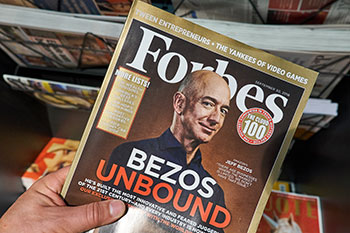Are you looking to take the next step in your career? Or maybe you want to raise your professional profile? Perhaps you want to position yourself as an influencer or authority in your chosen industry? Whatever the case may be, developing a strong personal brand will be an important first step. And if you’re one of those people who thinks that a personal brand is only for the self-promoters or show-offs out there, then it’s time to think again.
Apple, Starbucks and McDonald’s are all examples of companies with strong brand identities. Most business leaders and managers can appreciate the value of differentiating the company’s service or product offering from the competition. And, in essence, that’s exactly what a personal brand is all about. Your personal brand is your opportunity to showcase your expertise and enhance your value. And the good news is it’s not as hard as you might think to put one together. In this article, we take you through the steps needed to develop a strong personal brand, the easy way!
What Is My Personal Brand?
 In the pre-digital age, a personal brand consisted largely of a business card that you handed out at meetings or networking events. However, the advent of the web has changed all that. Most of us now have a LinkedIn profile as well as various social media accounts. You probably also follow a number of influencers or thought leaders in your industry. And so the idea of personal branding has become something much more all-encompassing than just a business card with a snazzy photo. The founder of Amazon, Jeff Bezos, summed it up nicely when he said:
In the pre-digital age, a personal brand consisted largely of a business card that you handed out at meetings or networking events. However, the advent of the web has changed all that. Most of us now have a LinkedIn profile as well as various social media accounts. You probably also follow a number of influencers or thought leaders in your industry. And so the idea of personal branding has become something much more all-encompassing than just a business card with a snazzy photo. The founder of Amazon, Jeff Bezos, summed it up nicely when he said:
‘Your brand is what people say about you when you’re not in the room!’ – Jeff Bezos
Personal branding is all about highlighting your expertise and knowledge, and positioning what makes you different from all the rest. It’s about demonstrating how you can add value. Simply put, it’s what makes you special and stand out from the crowd.
Benefits Of A Personal Brand
What difference will having a personal brand make? It’s a good question. Before you spend time on any activity, it’s important to check out whether it’s worth the investment of time and effort. And when it comes to having a strong personal brand, there are a number of benefits up for grabs including the following:
More job interviews: if you’re in the market for a new job or are wanting to take the next step in your career, a strong personal brand identity will help you get a foot in the door with more job interviews.
Better job offers: and alongside more job interviews will come better job offers. A strong personal brand means that employers can see straightaway the value you can add. In the ultra-competitive job market, shining a spotlight on yourself with a personal brand will be rewarded with better job offers.
Increased opportunities for promotion within the company: Similarly, a strong personal brand will see you getting noticed by your current employer. And you will find there are more opportunities for promotion, collaboration and high profile project working as a result.
 Position yourself as an influencer: You may have specialist knowledge and expertise in your industry that makes you unique. A strong personal brand identity will help you get that message out there. It could be via your social media profile on, for example, Instagram or Twitter. Or it could be through your LinkedIn profile and network or a personal blog. Check out the profiles of influencers and thought leaders that you follow yourself and you’ll see the one thing they have in common is a compelling personal brand.
Position yourself as an influencer: You may have specialist knowledge and expertise in your industry that makes you unique. A strong personal brand identity will help you get that message out there. It could be via your social media profile on, for example, Instagram or Twitter. Or it could be through your LinkedIn profile and network or a personal blog. Check out the profiles of influencers and thought leaders that you follow yourself and you’ll see the one thing they have in common is a compelling personal brand.
Develop partnerships: Quite simply your personal brand will open more doors for you in terms of collaborative partnerships that will see you develop your following further. For example, if you’re a personal trainer or into fitness, then collaborating in partnership with a creative videographer to develop videos for Facebook or YouTube could open up a whole new world of opportunity.
Creating A Personal Brand Identity
OK, I get that a strong personal brand identity could be to my advantage, but how do I get started? Well, it isn’t as hard as you might think. Follow the simple steps outlined below to identify your personal brand.
Step 1: Identify Your Special Expertise
The first step is to undertake a self-audit. What is it that makes you tick? Dig deep into yourself to identify your values, interests, strengths and passions. And then focus on the one thing you are genuinely great at and build your brand around it. Be honest though.
To be really meaningful a personal brand needs to be authentic and sincere. Potential employers, colleagues and followers will soon smell a rat if your personal brand is not the real you. A genuine, authentic brand makes it easier for your audience to trust and engage with you. Therefore, be sure to focus on real talents and qualities rather than those that you think people want to see.
Step 2: Identify The Value That You Add
 This is perhaps the hardest step. Some people see this as being more about being boastful or arrogant. Some even view it is as being about self-aggrandizement and that doesn’t come naturally to a lot of people.
This is perhaps the hardest step. Some people see this as being more about being boastful or arrogant. Some even view it is as being about self-aggrandizement and that doesn’t come naturally to a lot of people.
Rather than seeing it in those terms, instead consider how you can help people and the solutions that you offer. Spend some time reflecting on how your approach is different from other experts in the industry. Differentiation is the key thing here – simply saying you are the best or the most creative isn’t enough. You also have to demonstrate the ways in which you can add value.
Step 3: Present Your Personal Brand Identity
So, you’ve worked out your unique skills and expertise, what makes you different and the value that you offer. The final step is to present your personal brand to the outside world. But how do you go about doing that in a practical sense?
Well, there are a couple of options. Most people go down the route of preparing a personal brand statement – more on that below. Other options include portfolio websites that showcase your talents or personal blogs and vlogs as well as social media platforms. You may choose one or more of the options; however, the important point here is to be consistent in your presentation and messaging.
What Is A Personal Brand Statement
The most popular way to showcase your personal brand is through a succinct statement that sums up all the key elements. Use it for the about statement on your LinkedIn profile or the bio on Twitter and Instagram.
A personal brand statement is often likened to Hollywood’s ‘elevator pitches’, the idea being that a budding filmmaker has only a few moments to pitch his/her idea to a busy studio producer while they are riding in an elevator. It has to be memorable, different and exciting.
So, when it comes to writing your personal brand statement try and incorporate the following elements:
Describe your expertise: be upfront and say what it is you are good at and what you can bring to the table. Brevity is key here though – remember an elevator ride only takes a few seconds.
Describe your point of difference and the value that you bring: this is your chance to tell your story: how you’re different, the solutions that you offer and who your target audience or followers are. You should make it clear to your audience what’s in it for them and answer the ‘so what’ question that will be at the back of their minds. Two or three sentences is all you can allow yourself here.
Present a compelling conclusion: tie it all up together with a concluding sentence that also gives you some zing and creates a buzz around your personal brand.
Personal Branding Strategy
For some people, developing a personal brand statement will be enough. If you are looking for a new job or are positioning yourself for a promotion and improved opportunities with your current employer, then it may be all you need. A personal branding statement would be a great opener to a resume or intranet employee profile.
For others though who are looking to position themselves as influencers or thought leaders, a more comprehensive personal branding strategy may be required.
 The starting point for a strategic approach is to understand who your target audience is. It’s essential to spend time working out who your audience is, where to find them and what their pain points are as well as the solutions you can offer. If you have no clear sense of who is likely to want to engage with you, then you will find it much harder to build up a following and establish yourself as an industry expert or influencer.
The starting point for a strategic approach is to understand who your target audience is. It’s essential to spend time working out who your audience is, where to find them and what their pain points are as well as the solutions you can offer. If you have no clear sense of who is likely to want to engage with you, then you will find it much harder to build up a following and establish yourself as an industry expert or influencer.
It’s also worthwhile having a look at what others are doing in the field. If you already follow a few thought leaders take a critical look at what they are doing and how they are presenting themselves. There are always valuable lessons to be learnt from looking at the competition. So, check out what other people are doing in your niche and how successful they are.
Developing a highly visible digital presence has to be an essential part of any personal branding strategy. It may be that your industry or area of expertise lends itself to one or two platforms in particular. A chef, for instance, would probably identify YouTube and Instagram as their online platforms of choice, whereas a writer would choose a personal blog as their preferred medium. Make sure you keep all your social profiles up to date and have current content. In addition, be sure to add social channels to all your professional touchpoints so that you can start to build up relationships and connections within your niche area.
The final point to make about a personal branding strategy is the need to be flexible. Your personal brand isn’t cast in stone – it will naturally change and evolve over time. Be sure to review your personal branding strategy from time to time to ensure it is still working for you.
Examples Of Personal Branding
So, when it comes to personal branding who has set the bar high and provides a good example of how to do it well?
One great example is Neil Patel, a digital marketing and SEO guru who has been involved in multiple companies most recently Neil Patel Digital. Neil’s success is down to his very visible online presence which has been driven by his voracious blogging. He has written in-depth blogs for a variety of sites on an almost daily basis. Try googling any topic related to online marketing and chances are one of Neil’s blogs will be in the top five. His blogs are thoroughly researched, well-crafted and engaging which has earned him a reputation as a trusted thought leader.
Another great example of a strong personal brand is motivational speaker, vlogger and author Amy Landino. Amy is dedicated to helping people discover their passions and achieve their goals. Her personal brand is based very much around her name and personality and she uses YouTube extensively. With millions of views and more than 300,000 subscribers, Amy has become a leading authority on how to get digital attention.
 Mimi Ikonn of hair extension brand Luxy Hair focused her personal brand offering on adding value to her audience. She started off by creating hair tutorials on YouTube that people could easily follow along with. Very subtly she shows off her hair extensions in the videos without making them the main focus. Mimi then began to add other value-based content such as how to pick the right hair color. Mimi now has a following of over 3 million subscribers built up by positioning herself as being a trusted adviser to her audience.
Mimi Ikonn of hair extension brand Luxy Hair focused her personal brand offering on adding value to her audience. She started off by creating hair tutorials on YouTube that people could easily follow along with. Very subtly she shows off her hair extensions in the videos without making them the main focus. Mimi then began to add other value-based content such as how to pick the right hair color. Mimi now has a following of over 3 million subscribers built up by positioning herself as being a trusted adviser to her audience.
And when it comes to an authentic, trusted personal brand it’s hard to get beyond the example of former president Barack Obama and former first lady Michelle Obama. Even now, two years after they left office, the Obamas’ brand and influence both individually and collectively is still strong. Ask the average person what brand Obama stands for and the chances are they will use the same sorts of words: integrity, trust, charity and good causes. Now that is a very powerful example of a strong personal brand identity.
MyHub provides easy to set up and manage cloud-based intranet solution that can help your business communicate and collaborate, sign up a for a free trial or get in touch to book a free demo. Find out how we can support your personal brand.







0 Comments